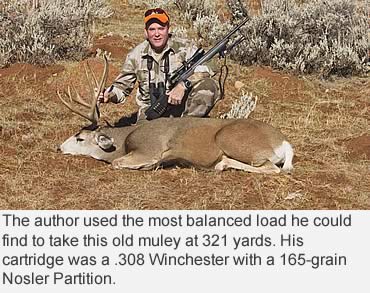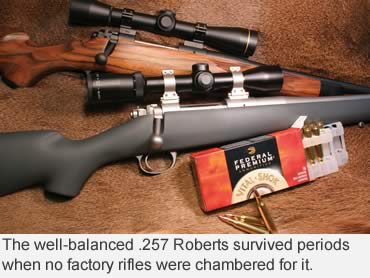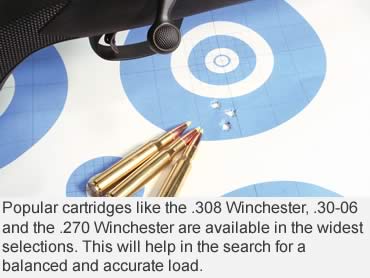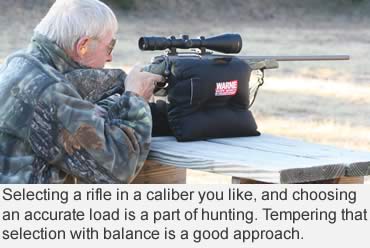How to sort out which load offers the most balance for your hunting rifle.
Balance is important in everything, even in hunting firepower. A ballistically balanced load offers the most power and the flattest trajectory with the least amount of recoil in a sporting-weight rifle.
Average muzzle velocity of the most popular big game cartridges is 2,750 fps. With muzzle energy, another number often used to compare cartridges, the average is 2,550 foot-pounds.
With regard to trajectory, if you sight in the most popular big game rifles at 100 yards, bullet drop at 300 yards will vary from about 9 inches to as much as 40 inches. Sixteen inches is a reasonable average.
There’s much more variance in recoil. Felt recoil is a subjective thing, influenced by stock design and fit. Average recoil of the most popular big game rifle is around 18 foot-pounds. Interestingly, that’s how much recoil most shooters say is within their comfort zone.
 The bulk of big game bullets weigh from 100 to 200 grains. Bullets for whitetails to elk-sized game weigh 55 to 300 grains. Average those numbers and split the difference, and you get 163.5 grains. For simplicity’s sake, call it 168.
The bulk of big game bullets weigh from 100 to 200 grains. Bullets for whitetails to elk-sized game weigh 55 to 300 grains. Average those numbers and split the difference, and you get 163.5 grains. For simplicity’s sake, call it 168.
Look for the rifle and cartridge that best matches these averages, and you’ll find an 8-pound .308 rifle shooting a 165-grain bullet comes very close.
A .30-06 loaded with the same bullet offers similar performance with a tad more recoil. The 7mm-08 with less recoil is another contender for the most balanced load.
There are many ways to make these comparisons. One is to divide muzzle velocity by muzzle energy. The closer the result is to 1, the more balanced the cartridge. Numbers higher than 1 trend toward a velocity advantage. Numbers less than one show an energy advantage.
Hunters can also find the most balanced cartridge for the longest distance they intend to shoot. Add the muzzle and downrange energy, and divide by two to get the average velocity and energy balance.
I made this calculation for the 16 cartridges shown in the graph (next page), using muzzle velocity and muzzle energy. Guess what? Our average cartridge, the .308 Winchester with a 165-grain bullet came in with a perfect balance score of 1.0.
 As an example of how you can use this to compare loads for a given cartridge, I worked these calculations for a New Ultra Light Arms bolt-action rifle in .30 Remington AR. Results for the three most accurate handloads I’ve developed, with 110-, 125- and 150-grain bullets, showed the 150-grain load is most balanced.
As an example of how you can use this to compare loads for a given cartridge, I worked these calculations for a New Ultra Light Arms bolt-action rifle in .30 Remington AR. Results for the three most accurate handloads I’ve developed, with 110-, 125- and 150-grain bullets, showed the 150-grain load is most balanced.
Trajectory is also important. Laser rangefinders have made compensating for bullet drop less difficult, but it’s still critical. The flatter the trajectory, the less correction you have to make. It’s easy to make a cartridge shoot flat, but not easy to make it shoot flat and not kick like an aggravated plow mule.
For this comparison, let’s go back to our average rifle cartridge with 18 foot-pounds of recoil and 16 inches of drop at 300 yards. If you can get less drop with less recoil, that’s a good thing. Less drop with more recoil, not so much. But how do we quantify or rate this?
An easy way is to add the recoil and trajectory at 300 yards and divide by the average recoil plus 16 inches of drop: 18 plus 16 equals 34. Results of less than 1 represent a positive relationship between trajectory and recoil. Results of more than 1 represent a negative relationship.
 I worked this out for my three .30 Rem AR loads and found the 110-grain cartridge offers the flattest trajectory for with the least amount of recoil. In most cases, as with the .30 Remington AR, the relationships are obvious if you just look at the numbers.
I worked this out for my three .30 Rem AR loads and found the 110-grain cartridge offers the flattest trajectory for with the least amount of recoil. In most cases, as with the .30 Remington AR, the relationships are obvious if you just look at the numbers.
Now, the key: Combine the velocity and energy relationship to the recoil and trajectory relationship to determine overall balance. By multiplying the velocity and energy balance by the recoil and trajectory balance, you’ll get the overall ballistic balance of the cartridge / load. The closer the number is to 1, the more balanced it is.
The results are really nothing more than common sense. The .223 Remington with its fast, light bullet shoots relatively flat with minimal recoil. The very unbalanced .45-70 kicks and hits hard and has a rainbow-like trajectory. Everything considered, the six most balanced cartridges on the list were not really a surprise.
Most balanced were the .308 Winchester with a 165-grain bullet, and the 180-grain .30-06. They scored a perfect 1.00.
In the No. 2 spot was the .257 Roberts with a 120-grain +P load. The third was a tie between a .270 Winchester and the 7mm-08 Remington.
One of the most respected cartridges worldwide, the .375 H&H, gets fourth-place honors. And in the fifth spot was my .30 Remington AR handload.
 With the exception of the .30 Remington AR, the top cartridges are six of the most popular big game cartridges of all time.
With the exception of the .30 Remington AR, the top cartridges are six of the most popular big game cartridges of all time.
Granted, the .257 Roberts is available only in limited quantities and from just a few manufacturers, but it survives, likely because of its balance. Its longevity and popularity might be the best proof that ballistic balance does indeed matter.
Ammunition sales figures indicate hunters have figured all this out on their own. Most likely their conclusions were based on field experience rather than statistics or formulas.
I’m not suggesting any cartridge is best for hunting big game, only that some are more balanced than others. You might not want balance. You might want a flat-shooting, light-recoiling cartridge like the .260 Rem. Or maybe you don’t mind the 32 foot-pounds of recoil a .300 Winchester Magnum round generates.
With my .30 Remington AR, the 150-grain handload was the clear winner, but this rifle actually only weighs 5.25 pounds with scope. These calculations were based on an 8-pound rifle.
Correcting the data to reflect this, the .30 Remington AR handload falls to ninth place on the list. In the lighter rifle, though, the 150-grain handload still delivers the best balance of all my handloads. And, that’s the load I’ll hunt with.
 Why would I choose it over the more balanced factory load? It shoots flatter and hits harder, and I appreciate the moderate recoil. The .30 Remington AR might not be as powerful as a .308 Win or a .30-06, but it is just as balanced.
Why would I choose it over the more balanced factory load? It shoots flatter and hits harder, and I appreciate the moderate recoil. The .30 Remington AR might not be as powerful as a .308 Win or a .30-06, but it is just as balanced.
Put either the .308 Winchester or .30-06 in a 5-pound rifle, and they become unbalanced because of the excessive recoil. So the key to cartridge selection depends on the weight of the rifle you like to carry, how much recoil you can withstand, how flat you want it to shoot and how hard you want it to hit.
With so many cartridges and ammunition options available, a hunter can assemble about any rifle/cartridge/load combination he wants. If you use factory ammo and want the most balance in an 8-pound rifle — a very common big game rifle weight with a scope — choose a .308 Winchester with a 165-grain bullet or a .30-06 with a 180-grain bullet.
Smart hunters have been preaching this fact and using these cartridges for a long time. Sometimes, you don’t need cool formulas, a calculator or even a gun writer to figure things out.
NOTE: All ballistic data was obtained from manufacturer’s catalogs. Recoil energy was established with the Sierra Infinity ballistics program. All data should be considered nominal in nature. Exact velocity, energy, trajectory and recoil will vary from load to load and rifle to rifle. (H) Indicates handload.
Read Recent GunHunter Articles:
• Smith & Wesson’s 686 Revolver: This brother of the Model 19 is great for hunting and plinking.
• Remington’s Classic Rimfire: After 54 years of service, the Model 552 Speedmaster is still one of the sleekest .22 autoloaders available.
This article was first printed in the July 2011 edition of Buckmasters GunHunter Magazine. Subscribe today to have GunHunter delivered to your home.